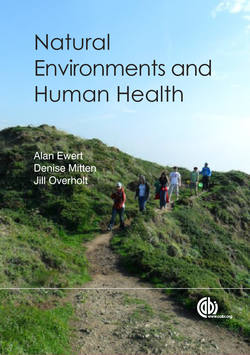Читать книгу Natural Environments and Human Health - Alan W Ewert - Страница 14
На сайте Литреса книга снята с продажи.
References
ОглавлениеAndrews, M. and Gatersleben, B. (2010) Variations in perceptions of danger, fear and preference in a simulated natural environment. Journal of Environmental Psychology 30(4), 481.
Blonna, R. (2011) Coping with Stress in a Changing World, 5th edn. McGraw-Hill, Boston, Massachusetts.
Bruni, C.M., Chance, R., Schultz, P.W. and Nolan, J. (2012) Natural connections: bees sting, snakes bite, but they still are nature. Environment and Behavior 44(2), 197–215.
Cheng, J. and Monroe, M.C. (2012) Connection to nature: children’s affective attitude toward nature. Environment and Behavior 44(1), 31–49.
de Vries, S., Verheij, R.A., Groenewegen, P.P. and Spreeuwenberg, P. (2003) Natural environments – healthy environments? An exploratory analysis of the relationship between greenspace and health. Environment and Planning A 35(10), 1717–1732.
Ewert, A. and Galloway, G. (2012) Take a park, not a pill: promoting health and wellness through adventure programming. In: Martin, B. and Wagstaff, M. (eds) Controversial Issues in Adventure Programming. Human Kinetics, Champaign, Illinois, pp. 130–137.
Johansson, M., Hartig, T. and Staats, H. (2011) Psychological benefits of walking: moderation by company and outdoor environment. Applied Psychology: Health and Well-Being 3(3), 261–280.
Kline, J.T., Rosenberger, R.S. and White, E.M. (2011) A national assessment of physical activity in US National Forests. Journal of Forestry 109(6), 343–351.
Larivière, M., Couture, R., Ritchie, S.D., Côté, D., Oddson, B., et al. (2012) Behavioural assessment of wilderness therapy participants: exploring the consistency of observational data. Journal of Experiential Education 35(1), 290–302.
Louv, R. (2005) Last Child in the Woods: Saving Our Children from Nature-Deficit Disorder. Algonquin Books of Chapel Hill, Chapel Hill, North Carolina.
Lyytimaki, J. (2012) Indoor ecosystem services: bringing ecology and people together. Human Ecology Review 19(1), 70–76.
Maller, C., Townsend, M., Pryor, A., Brown, P. and St. Leger, L. (2006) Healthy nature healthy people: ‘contact with nature’ as an upstream health promotion intervention for populations. Health Promotion International 21(1), 45–54.
Mitten, D. (1994) Ethical considerations in adventure therapy: a feminist critique. In: Cole, E., Erdman, E. and Rothblum, E.D. (eds) Wilderness Therapy for Women: The Power of Adventure. The Haworth Press, Binghamton, New York, pp. 55–84.
Mitten, D. (2004) Adventure therapy as a complementary and alternative therapy. In: Bandoroff, S. and Newes, S. (eds) Coming of Age: The Evolving Field of Adventure Therapy. Association of Experiential Education, Boulder, Colorado, pp. 240–257.
Mitten, D. (2009) Under our noses: the healing power of nature. Taproot Journal 19(1), 20–26.
O’Brien, L., Burls, A., Bentsen, P., Hilmo, I., Holter, K., et al. (2011) Outdoor education, lifelong learning and skills development in woodlands and green spaces: the potential links to health and well-being. In: Nilsson, K., Sangster, M., Gallis, C., Hartig, T., de Vries, S.,. (eds) Forests, Trees and Human Health. Springer, New York, pp. 343–372.
Outdoor Foundation (2011) Outdoor Recreation Participation Report 2011. Outdoor Foundation, Boulder, Colorado.
Pergams, O.R.W. and Zaradic, P.A. (2008) Evidence for a fundamental and pervasive shift away from nature-based recreation. Proceedings of the National Academy of Sciences USA 105(7), 2295–2300.
Russell, K.C. (2003) An assessment of outcomes in outdoor behavioral healthcare treatment. Child and Youth Care Forum 32(6), 355–381.
Smith, B.J., Tang, K.C. and Nutbeam, D. (2006) WHO health promotion glossary: new terms. Health Promotion International 21(4), 340–345.
US Department of Health and Human Services (2000) Healthy People 2010. Government Printing Office, Washington, DC.
World Health Organization (1948) Preamble to the Constitution of the World Health Organization as adopted by the International Health Conference. Official Records of the World Health Organization 2, 100.
